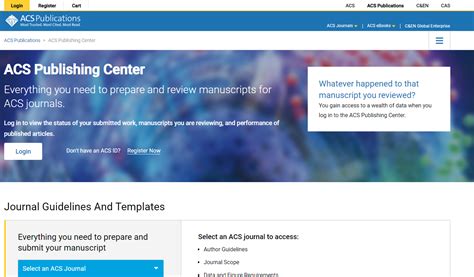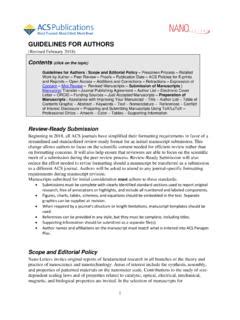When it comes to publishing in prestigious scientific journals, such as those published by the American Chemical Society (ACS), authors need to ensure their manuscripts meet the highest standards of quality, clarity, and adherence to specific guidelines. The ACS, being one of the leading publishers of chemical research, offers a wide range of journals that cater to various disciplines within the field of chemistry. Here are five tips that can help authors successfully publish their research in ACS journals.
Understanding the Journal’s Scope and Audience

Before submitting a manuscript, it’s crucial to understand the scope and audience of the target journal. Each ACS journal has its specific focus, whether it’s on organic chemistry, inorganic chemistry, biochemistry, or another area. Authors should carefully review the journal’s aims and scope, recent publications, and the types of articles it typically publishes. This helps in determining whether the research is a good fit for the journal and allows authors to tailor their submission accordingly. For instance, Journal of the American Chemical Society (JACS) is a broad-spectrum journal that publishes original research of exceptional significance, while ACS Applied Materials & Interfaces focuses on interdisciplinary research at the interface of materials science and other disciplines.
Selecting the Appropriate Article Type
ACS journals offer various article types, including research articles, letters, reviews, and perspectives, among others. Choosing the right article type is essential as each has its specific requirements and word limits. For example, a communication or letter is typically brief and reports on significant, timely research that demands urgent publication, whereas a full research article provides a comprehensive report of a more extensive study. Understanding these differences helps authors to present their work in the most appropriate format, increasing the likelihood of a successful submission.
| Article Type | Description | Word Limit |
|---|---|---|
| Research Article | Comprehensive report of original research | Varies by journal |
| Communication/Letter | Brief report of significant, timely research | Typically 2-4 pages |
| Review | Comprehensive review of recent developments in a field | Varies by journal |

Ensuring High-Quality Figures and Graphics

Figures and graphics are crucial components of scientific publications, as they help to clarify complex concepts and data. ACS journals have specific guidelines for figures, including requirements for resolution, size, and formatting. Authors should ensure that all figures are of high quality, clearly labeled, and easy to understand. This includes using appropriate scales, legends, and captions. High-quality figures not only enhance the readability of the manuscript but also contribute to its overall impact and the author’s ability to effectively communicate their research findings.
Adhering to Manuscript Preparation Guidelines
Each ACS journal provides detailed guidelines for manuscript preparation, covering aspects such as formatting, word limits, reference styles, and the submission process. Authors must adhere strictly to these guidelines to ensure their manuscript is considered for publication. This includes using the correct template for the chosen article type, properly formatting equations, tables, and figures, and following the specified reference citation style. Failure to comply with these guidelines can lead to delays in the review process or even rejection without review.
Key Points for Successful ACS Publishing
- Understand the journal's scope and audience before submission
- Select the appropriate article type based on the nature of the research
- Ensure all figures and graphics are of high quality and follow journal guidelines
- Adhere strictly to manuscript preparation guidelines
- Engage with the editorial process constructively, addressing reviewer comments thoroughly
Engaging Constructively with the Editorial Process
Once a manuscript is submitted, it enters the peer-review process, where it is evaluated by experts in the field. Authors should be prepared to receive and respond to comments from reviewers and editors. Engaging constructively with the editorial process involves addressing each comment thoroughly, making necessary revisions, and providing a clear, professional response to the reviewers. This process not only improves the quality of the manuscript but also demonstrates the author’s commitment to scholarly communication and their willingness to ensure the highest standards of their research.
In conclusion, publishing in ACS journals requires a deep understanding of the journal's focus, adherence to specific guidelines, and a commitment to presenting high-quality research. By following these tips, authors can enhance their chances of successful publication and contribute meaningfully to the scientific community through the dissemination of their research findings.
What is the importance of selecting the right article type for ACS journals?
+Selecting the right article type is crucial as it allows authors to present their research in the most appropriate format, increasing the likelihood of a successful submission and ensuring that their work is communicated effectively to the target audience.
How can authors ensure their figures and graphics meet ACS journal standards?
+Authors can ensure their figures and graphics meet ACS standards by following the journal’s guidelines for resolution, size, formatting, and labeling. It’s also beneficial to consult previously published articles in the target journal for examples.
What happens if a manuscript does not adhere to the ACS journal guidelines?
+If a manuscript does not adhere to the guidelines, it may be rejected without review or returned to the authors for revision before it can be considered for publication. Adhering to the guidelines is essential for a smooth and successful submission process.


